We are reposting this classic list about the Olympics.
The Olympic Games come around every four years although technically it’s now every two years since the summer and winter games are on a staggered schedule. Most people are all familiar with the popular Olympic sports. In the summer games the main focus is on track and field, gymnastics, swimming and in recent years, beach volleyball. In the winter games most of the attention is on figure skating, skiing, hockey and, due in part to the Jamaicans, bobsledding. If you are a real die hard Olympics fan, you might watch some of the more obscure sports, badminton, curling, the pentathlon or the biathlon on some of the late night cable channels. The 2012 Summer Olympic Games included 26 sports (with 2 more to be added in the 2016 games). The 2014 Winter Olympics will include 7 sports. However, over the history of the modern Olympic Games, there have been a great number of sports that made a brief appearance. Some are fairly well known, such as baseball and softball. Others are more obscure, while still others may be complete head scratchers. Still each sport was probably very important to those who competed and they deserve their moment in the spotlight
10. Plunge Diving
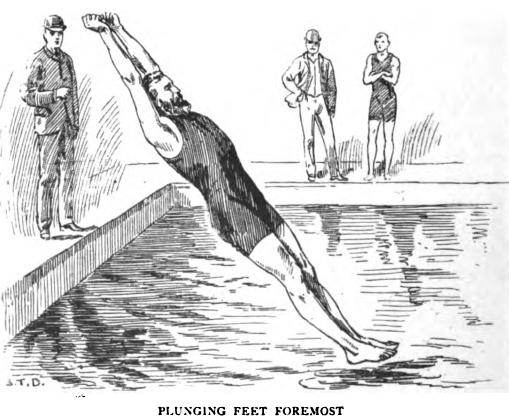
Picture of a swimmer plunging feet first (the plunge for distance was a competitive swimming event in the 19th and early 20th century
Also known as plunge for distance this was part of aquatics, which encompasses water disciplines such as swimming, diving and water polo. Its only appearance was at the 1904 Summer Games in St Louis. Plunge for distance was a diving long jump. Competitors dove into the pool from a standing position and their attained distance was measured after either 60 seconds passed or their head broke the surface, whichever came first. Divers could not propel themselves through the water after the initial dive as they were required to remain motionless. An interesting note. There were only five entrants in the plunge diving competition, all of them from the United States. Needless to say, the Americans swept the medals.
9. Croquet

The 1900 Olympic croquet tournament
This was another sport that had only one appearance, in the 1900 Summer Games in Paris. Even though there were three events, Singles (one and two balls) and Doubles, there were only ten competitors, nine of whom were from France. There was one competitor from Belgium, but he didn’t make it through the first round. Another surprising note, there three of the competitors were women and they competed against the men. Not surprisingly, France swept all the medals taking gold, silver and bronze in both the singles competitions and the gold medal in the doubles competition – apparently only one team entered the doubles. It’s too bad the competitor from Belgium couldn’t find a partner, they would have been a shoe in for the silver.
8. Motorboat Racing
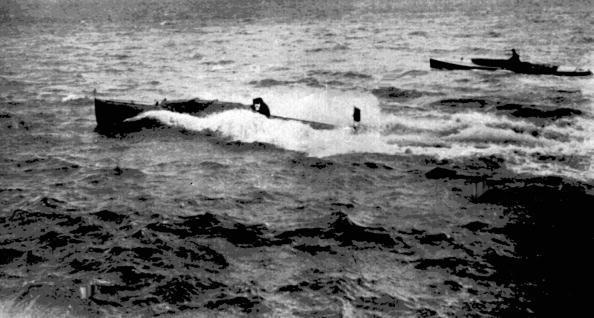
London 1908: Motor boats in action during competition when the sport was included for the first and last time. The races were held round the Isle of Wight off the south coast of Britain.
This was another one hit wonder in the Summer Games. The 1908 Summer Games in London was the only time that any kind of motorized sport has taken place in the Olympic games (although it was a demonstration sport in the 1900 games). There were three separate events each for its own class of motorboat. Each race consisted of five laps around an eight nautical mile course. Unfortunately, someone must have forgotten to inform Mother Nature that this was the Olympic Games, because even though multiple boats started each race, only one managed to complete each one. This was mainly due to gale force winds that swept over the course. The fact that motorboats had only been invented around 20 years earlier may have contributed to this as well. So the final medal count was three gold and zero silver and bronze. Ironically, the races had originally been scheduled for July, but were pushed back a month at the request of the Duke of Westchester and Lord Howard de Walden who were visiting America during the original July date. Another note of interest, one of the boats from those races was recently bought and completely restored by a British collector.
7. 200 Meter Obstacle Swim
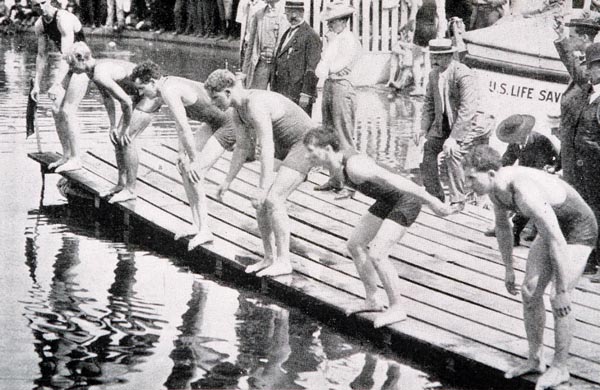
In Paris 1900, swimming took place on the Seine and included an obstacle race and one where the point was to swim the whole distance under water.
Continuing with one and done events is the 200 meter Obstacle Swim, which is pretty much what it sounds like. This curious event took place (like Croquet) at the 1900 Summer Games in Paris. Like all the swimming races in the Paris Games, the Obstacle Race took place in the River Seine. Competitors were rowed out 200 meters from shore and traverse three different obstacles in the race. First they had to climb over a pole, then over a row of boats, then finally under another row of boats. Unlike the previous entries, this event had enough competitors (12 from 5 nations) to have semi-final heats. However, since the top ten times qualified for the finals so it seems that it might have been just a really a cruel trick to play on the two non-qualifiers (one of which was Fred Hendschel, the only competitor in the race from the United States).
6. Two-Handed Throws
Yet another one-time appearance. Although technical this is three one-time appearances rolled into one. In the 1912 Summer Games in Stockholm, in addition to the regular shot put, javelin and discus events, there was also a two-handed version of each. All three were scored the same. Each competitor got three throws with their left hand and then three throws with their right hand. The longest throws from each hand were added together to get the total distance. Surprising (or maybe not that surprisingly) there were many duplicate medal winners in the one-handed and two-handed events. In the javelin, Julius Saaristo of Finland won the silver medal in the one-handed and the gold in the two-handed. In the discus, Armas Taipale of Finland won the gold in both the one-handed and two-handed. And in the shot put, the top four throwers in the one-handed event were the same as those in the two-handed, though they finished in a different order.
5. Rope Climbing
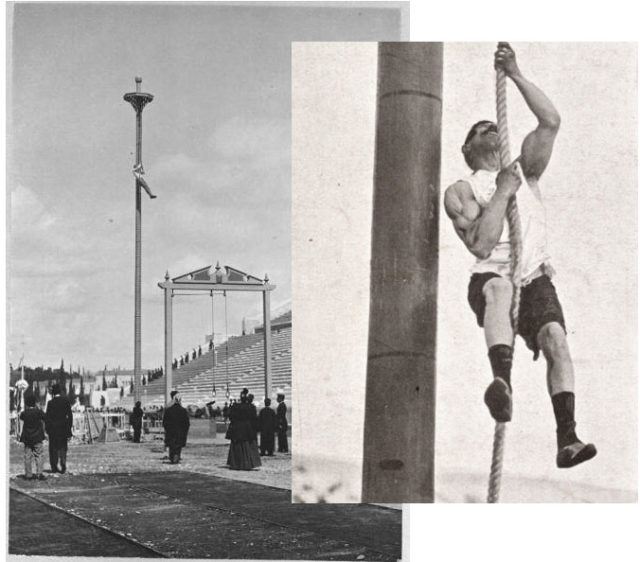
A gymnast competes in the rope-climb at the 1896 Olympic Games in Athens, Greece
Unlike the previous entries, rope climbing was part of four different Olympic games, including the inaugural Modern Olympics Games of 1896 in Athens. Rope climbing was part of the gymnastics program. At its high point in the 1924 Paris Olympics, it had seven competitors from nine nations. Rope climbing has had a long and often times popular standing around the world, although maybe not that popular if you were subjected to rope climbing in high school gym class. In the United States, competitive rope climbing was sanctioned by the NCAA until the early 1960’s. There are still international rope climbing events held today. In the rope climbing competitors started from a sitting position and could only use their arms to climb. In Olympic competition both time and style (keeping the legs horizontal to the ground) were considered in scoring.
4. Tug of War
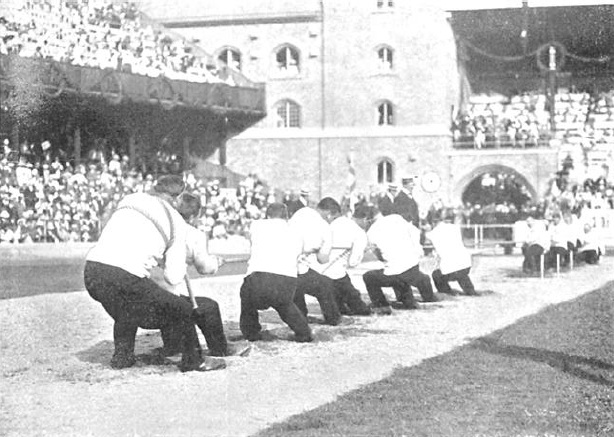
Tug of war was contested as a team event in the Summer Olympics at every Olympiad from 1900 to 1920
This somewhat familiar sport, probably most often experienced on the playground as kids, was a regular competition, making five appearances in the Olympic Games from 1900 to 1920. In the 1904 St. Louis Games, the American teams (two of which were from the same St. Louis athletic club) swept the medals probably giving a new meaning to home field advantage. Four years later, at the 1908 London Games, Great Britain returned the favor by sweeping all three medals on their home turf. Interestingly, all three British teams were composed of police officers. The 1908competition was not without its controversy, however. The American team, composed mostly of competitors in the throwing events (they had collectively won 16 Olympic medals in the discus, shot put and hammer throw events) were soundly defeated in the first pull by the Liverpool Police team. The Americans launched a protest stating that the boots worn by the British team constituted illegal footwear. The British team countered that the boots were part of the standard police attire. The protest was disallowed and the American team withdrew in disgust.
3. Skeleton (Cresta)

This may seem like a surprising entry to those out there who follow the Winter Games. Skeleton has been a regular sport in the Winter Olympics since 2002. For those not familiar Skeleton is similar to the luge except that the competitors ride face first and on their stomachs instead of feet first and on their backs. However, what makes this event so unusual is that until 2002, it was only included when the Winter Games took place in St. Moritz, Switzerland, apparently because they were the only one that had an actual Skeleton (or Cresta Run) track. Unfortunately for the Skeleton enthusiasts, the games had only been at St. Moritz twice (in 1928 and 1948). To add another interesting twist American John Heaton won the silver medal in the 1928 games (behind his older brother Jennison). He then came back to St. Moritz 20 years later for the 1948 games and again won the silver medal in the Skeleton, giving him the record for the longest span between winging two Olympic medals for the same event. To top everything off, or because he was bored in between the two St. Moritz games, he also won the bronze medal in the two-man bobsled at the 1932 Lake Placid Winter Games.
2. Live Pigeon Shooting
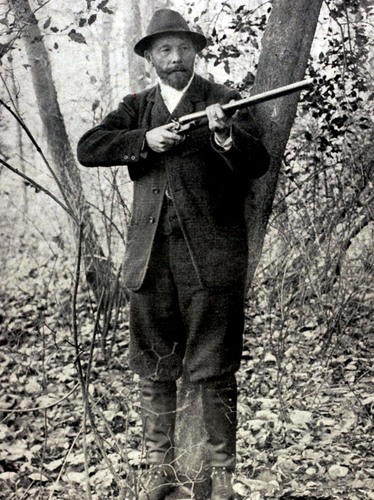
Leon de Lunden of Belgium won the live pigeon shooting event at the 1900 Olympics in Paris — the only time in Olympic history when animals were killed on purpose.
Unfortunately, this is disgusting event is exactly what it sounds like. Live pigeons were released one at a time and competitors tried to shoot as many in a row as possible. As soon as a competitor missed two birds, they were eliminated. Nearly 300 birds were shot and killed. As one might expect this event turned quite messy as the field soon became littered with dead and wounded birds, feathers and blood. To add to the weirdness, an award of 20,000 Francs was the prize for the winner. The top four finishers agreed to split the prize. Fortunately animal rights groups made enough noise that the Olympics organizers switched to clay pigeons in all their subsequent games. There has been some debate over the years on whether or not this was an official Olympic event and the IOC (International Olympic Committee) has been reluctant to verify it. Either way, thankfully this marked the only time in Olympic history that animals were killed on purpose. There was another shooting event called the 100 meter running deer that was included in the Olympics from 1908 to 1948 but fortunately for Bambi enthusiasts, the “deer” were just cardboard cutouts that moved sideways across an open field.
1. Ice Hockey and Figure Skating (Summer Olympics)
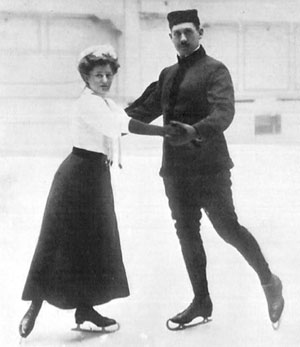
Anna Hubler and Heinrich Burger, who captured the pairs figure skating competition at the 1908 Summer Olympics. (The Fourth Olympiad London 1908 Official Report)
Before anyone starts calling foul and stating the obvious; that ice hockey and figure skating can hardly be considered unusual or surprising Olympic events, please continue reading. Certainly both of these sports have been the cornerstone sports of the Winter Olympic Games from the very beginning. Who can forget the incredible figure skating of people like Sonja Henie, Peggy Fleming, Kristi Yamaguchi, Brian Boitano and Scott Hamilton? And who doesn’t still get shivers of national pride when we think about the Miracle on Ice team of the 1980 Lake Placid Olympics? So what makes these two obviously well-known Winter Olympic sports usual? Because both of these sports made their Olympic debut in the Summer Olympic Games.
That’s right, these ice based sports were both briefly part of the Summer Olympics. Figure skating debuted in the 1908 Summer Games in London. While the other “warm weather” events were held in April, the figure skating was held at the end of October, which made the London Games the longest in modern Olympics history. Figure skating returned, this time along with ice hockey, in the 1920 Summer Games in Antwerp. Fortunately, an indoor ice arena, the Palais de Glace d’Anvers, was available to host both events so they were able to be held in April along with the other “summer sports”.
Perhaps appropriately, considering their influence on the development of modern hockey, Canada was the winner of the first Olympic ice hockey gold medal, with the United States taking the silver and Czechoslovakia snatching the bronze. Four years later the Winter Olympic Games debuted in 1924 in Chamonix. These inaugural Winter Games included skiing, bobsledding, curling, and of course, figure skating and ice hockey.
Michael Young was born and raised in Iowa. In 1996, a lifelong dream was fulfilled when he attended the Olympic Games in Atlanta with his oldest son. He has been a school teacher and an insurance underwriter. He is currently working on his Master’s Degree in Social Work at the University of Iowa.

No comments:
Post a Comment